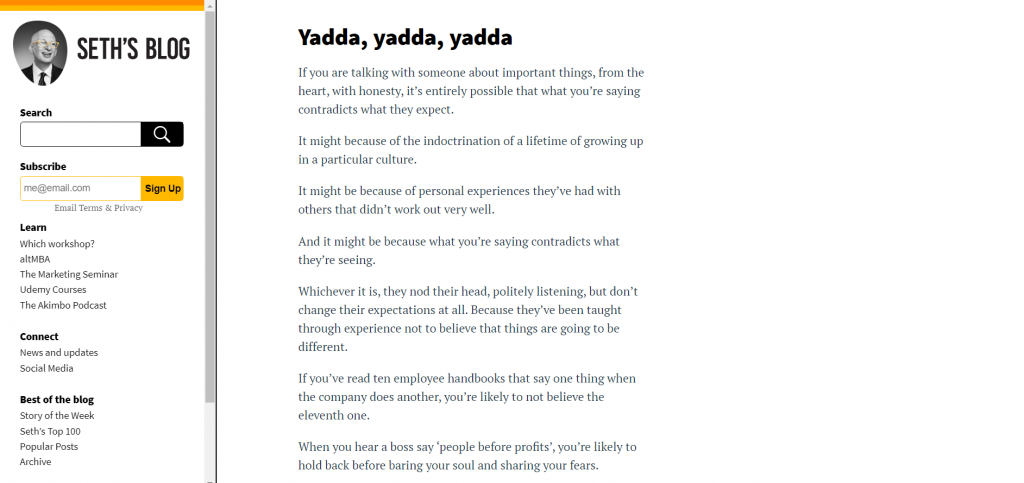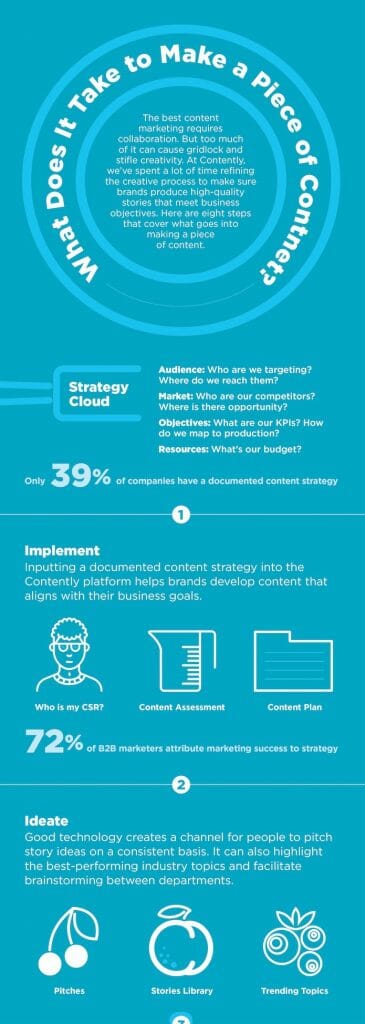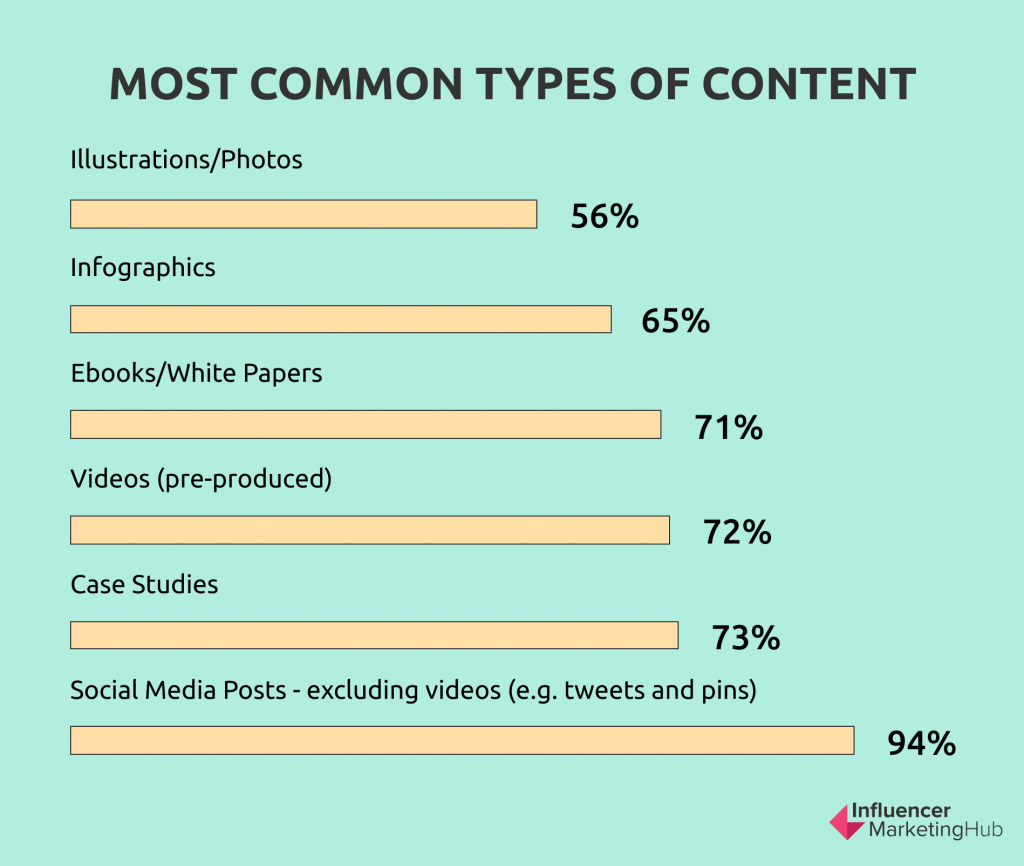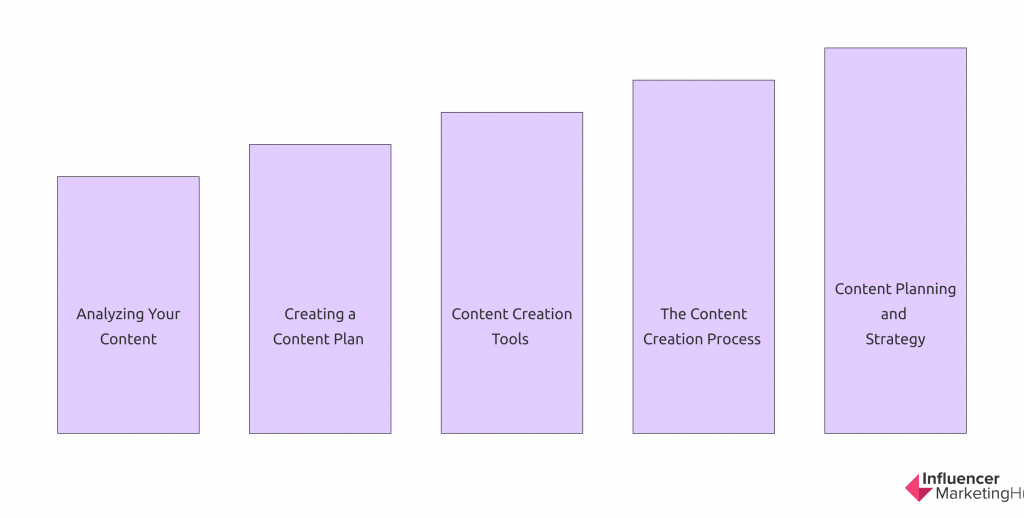Nowadays, anyone from anywhere in the world can make content, but not everyone can create content that actually works or makes an impact on their target audience. Content is everywhere on the web, and you interact with it regularly. From YouTube videos to blogs, content takes on a lot of forms and can vary greatly from website to website.
With a plethora of content available on the web, it seems easy to jump on the bandwagon and start making your own content. You’ll get to do what you love the most, and people will flock to your website, right? Well, yes and no. There’s more to content creation than just starting a blog or a YouTube channel. While there’s no exact formula when it comes to content creation, there are a number of steps you can follow that will help make your content more effective.
How to Create Content that Actually Works: A Content Creation Guide for Beginners:
What Is Content Creation?
So what exactly is content creation? From an outside perspective, it might seem like an easy task. After all, content creation can essentially be broken down into three simple steps. All content creators have to do is come up with an idea, execute it, and publish it to their preferred platform.
While that may be true to some extent, as those three steps are key aspects of content creation, that’s oversimplifying things. Content creation entails a lot of careful planning, strategic execution, and skill.
Content creation, simply put, is a process that requires content creators to:
- Come up with ideas that will appeal to your audience
- Determine the form you want it to be in and the platform you want to publish it on
- Come up with a content creation strategy, which can include SEO, market and persona research, and content audit
- Publish your content
Types of Content
As we’ve mentioned before, content can take on a lot of forms. When used optimally, these can drive more traffic to your site. You’re free to stick to just one type or experiment with a combination of different content types. Here are some of the more common ones:
- Blogs
One of the most popular content types, blogs are used by many brands as part of their content marketing strategy. What makes blogs great is that they can easily be discovered on search engine results pages (SERPs), and they’re generally easy to read and share. They’re a great tool for establishing a relationship with your audience, as they’re easily accessible.
While blogs as content come with a lot of benefits, they can also be subject to pitfalls. Not maintaining your blog and optimizing it for SEO and leads can adversely affect your site’s performance.

Source: seths.blog
- Long-form content
Long-form content, such as how-to guides and in-depth articles, are like blog posts on steroids. They usually fall around the 5,000 to 15,000-word count and offer more value.
- Infographics
If you want to convey information in a way that’s easy to understand, infographics provide you with a welcome alternative. Because they present data or information in a visual format, they tend to be easily shareable by your audience.

Source: contently.com
- Memes
Memes are everywhere. They’re hugely popular and can be used in practically anything, from blog posts to serious articles. They provide readers with something humorous. But while they’re easily shareable and adaptable, memes usually offer little to no additional value. When they’re not utilized properly, there’s a risk that your audience might not resonate well with them.
- Videos
Videos are another type of content that can effectively engage your audience. You can upload your edited videos to your YouTube channel and promote them to all your other social media platforms.
- Reviews
Reviews, whether they’re product, video, or book reviews, are an effective way to convey to your audience that you’re knowledgeable about a certain topic. This, in turn, establishes your authority or expertise in a particular subject.
- Case studies
If you want to establish yourself as a thought leader in your industry, one of the things you should look into is publishing case studies. These are in-depth studies of a particular subject or topic and often use your own data from your research.
- White papers
In a similar vein to case studies, white papers also provide readers with an in-depth look at a specific topic. A typical white paper presents the reader with a problem and then proceeds to provide a solution for it. According to HubSpot’s Lindsay Kolowich Cox, a good white paper has the following characteristics:
- Sufficient length
- A well-organized structure
- Denser than eBooks
- Has the proper format
- Utilizes the appropriate style
- Downloadable materials, such as eBooks, templates, and reports
One of the reasons why a visitor goes to your site is they want to get something that has value. You can provide them with what they need through downloadable materials, such as eBooks, templates, and digital reports. These act as excellent source materials and are relatively easy to create. To generate leads, you can ask your audience to opt in to your newsletter or email subscription list, so they can get access to your downloadable materials.
The Importance of Content
Content has become a crucial and inevitable part of daily life. You’ve probably heard the phrase “Content is king” countless times. While that may be true, there are some exceptions to the rule. Not just any kind of content can make it to the top.
The ones that make it to the top are the high-quality ones. They are engaging and provide a lot of value for the readers. They can drive traffic to your pages and encourage your visitors to take action on your site. Moreover, when users find your content valuable, they’re more likely to interact with it and share it, contributing to the content’s longevity.
Producing high-quality content also cements your reputation as a thought leader in your respective industry. What you produce is a reflection of your knowledge, skill, and expertise in your industry. Showcasing what you know in the best way possible and making it easily accessible to your audience helps you, as a creator, establish a relationship with your viewers. This, in turn, can encourage them to engage and interact with your brand.
Creating high-quality content also comes with other benefits for content creators. These include:
- Better online visibility
- Increased website traffic
- Improved brand awareness
- Better ranking positions on SERPs
- Capability to reach your intended audience
- Generating more leads while being cost-effective
- Increased revenue
Other factors to consider when creating high-quality content include:
- The right information for your niche and audience
- Internal links
- Keywords
Keep in mind that visitors come to your site looking for content, shares Jennifer Kyrnin. All the other aspects of your site or page, such as the design and user interface, complement your content to deliver something of high value and quality to your visitors.
What to Know Before Creating Content
Before you actually get down to work, there are several things you need to do or know about before you start creating content.
-
Know your goals
As with any endeavor, it’s important for you to determine your content creation goals. These will help guide the direction you’re going with and can determine the type of content you’re going to make. Note that it’s always best to create content that aligns with your marketing goals.
If you don’t know where or how to begin, you can always ask yourself why you’re creating the content you’re about to make. What are you looking to achieve with your content? Do you want to gain more traffic or more conversions? Perhaps you want to work on improving audience engagement? Jeff Haden emphasizes the value of having an underlying goal. According to him, without a “strong why,” your efforts, regardless of what you come up with, “will fall flat.”
Moreover, you need to come up with a way to measure or determine whether or not you’ve achieved your goals. For this, you need to set your key performance indicators or KPIs. Your KPIs will help you measure results and determine whether or not you’ve achieved your goals. Your KPIs can include SEO, website traffic, sales, and revenue.
-
Know your audience
Creating the kind of content you actually want is an exciting prospect, but amid the excitement, you might lose track of who your target audience is.
Content creation requires research. You will need to know and understand your audience before engaging in actual content creation work.
One of the tried-and-tested methods to gaining a better understanding of your audience is by creating a buyer persona. This can be a time-consuming process, but it gives you more in-depth results when it comes to defining who your ideal audience is.
More than creating a buyer persona, you need to engage with your audience by actually getting them involved. You can interact with them and ask them for feedback. You can also check out your audience demographics to give you an idea of who your readers are and where they’re coming from.
According to Jodi Harris, three key questions need to be considered when evaluating your capabilities in creating content:
- Who will make the content? This includes contributors or collaborators.
- How do you ensure that your content format matches your content creation goals?
- How do you create content that your audience will actually like and engage with?
The Content Creation Process: A Content Creation Guide
Get Inspired or Gather Ideas
Every great piece of content begins with an idea.
But coming up with a brilliant idea is one of the most difficult things creators have to face. How do you generate a novel or interesting idea? What will make your work stand out from a sea of content?
One way to approach this seemingly Herculean task is to focus on your audience. Use what you’ve researched to your advantage. Find out what their pain points are or what they’re frequently searching for, and start from there. You might uncover questions from your research that can make for a great topic.
You can also brainstorm with your team to come up with content creation ideas. You can get inspiration from a variety of methods, be it keyword research, interactions with your audience, or even competitor analysis.
Don’t Forget the Value of Quality
It might be tempting to churn out a lot of content or frequently use long-form articles for your website. While length might not directly affect results, there’s a point of diminishing returns that you need to know about and consider, says Neil Patel. Think of it this way, just because the content is longer doesn’t mean it’s better than something with a shorter word count. A 50,000-word guide might not be as effective or as definitive as a shorter counterpart.
When it comes to content, quality, more often than not, trumps quantity.
Find the Right Tools
The right tools can help you create more effective content. There are a number of tools that are readily available online, such as Canva for creating graphics and designs and Grammarly for checking your writing. There are also tools that let you create a buyer persona. For social media influencers, you can use tools that can make your photos and videos stand out. These include VSCO and CutStory.
Audit Your Content
Content audit is pretty straightforward and beneficial for both beginner and veteran content creators. Similar to a traditional audit, a content audit is taking stock of what you’ve come up with so far.
It enables you to get a better understanding of the type of content, topics, and categories that your audience typically engages with.
To begin your audit, create a spreadsheet where you’ll compile all your content. For each content piece that you’ve created, you then create columns where you define categories, such as keywords, buyer persona, content type, category, analytics, and more.
Select Your Format
Next, you need to determine which format you’d use for which content. With all the content types available, it can be difficult for creators to find the best one to use. To help make things easier, you need to go back to your buyer persona and audience research. Which format does your audience enjoy the most? Which types do they often engage with?
Whatever format you decide to use, there are four key qualities that every piece of content should possess, according to Seth Godin. These are:
-
Emotion
Determine what type of emotion you want your audience to feel through your content.
-
Change
How is your content affecting your audience? Does it necessitate any change in them?
-
Alert
How do you alert your readers whenever you have new material?
-
Share
How do you encourage your audience to share your content with others?
Create an Editorial Calendar
Creating an editorial calendar is a crucial part of content creation. It guides you on your content publishing journey, enabling you to know when to publish which content and which platform to publish it on.
One of the easiest tools you can use for this is Google Calendar. You can also use project management tools, such as Asana and Monday.com. When setting up your editorial calendar, make sure that you take into account your goals. Try to schedule your goals in such a way that you’re able to achieve them in a faster and more efficient way.
Transform Your Ideas into Content
After careful planning and coming up with a content creation strategy, you can then start creating your content. As with the previous steps, you have to refer back to your buyer personas and audience research. Determine what type of content will make them perform your desired action.
You can also refer to the results of your keyword and market research. If you’re specializing in blogs or long-form articles, you’d want to follow SEO best practices to optimize your website and your content for search engine rankings.
The creation process is also an ideal avenue for you to showcase your authority to your audience and establish yourself as a thought leader.
After creating your content and before you decide to publish your work, it’s important that you do some content editing. It’s a good idea to get another person to take a look at your work and get a clear and unbiased review. This way, you can deliver content that reads well, is free of errors, and makes sense.
If you find it difficult to come up with new content, you can rewrite an old article or breathe new life into your old content. Update your old work and relaunch it like you would a new piece, suggests Andy Crestodina. He adds that for this to work, you shouldn’t change your old content’s URL, especially if other sites have already linked to it. Moreover, you can change its content type. Say you have an article that needs updating. Instead of rewriting it as an article, you can turn it into an infographic or a video.
Publish Your Work
Now you’re ready to publish your work. Check your editorial calendar, so you’ll know which content goes where and when to best publish it. Follow your calendar as best as you can for consistency. If you run your own website, publishing content is as easy as clicking a button or two. If you’re thinking of having your work published elsewhere, then check your editorial calendar for the best time to pitch your content to other sites.
After you’ve published your work, the job still doesn’t end there. You need to work on promoting your content to your audience. For this, you’d want to create a promotion plan based on your buyer persona. There are several channels where you can promote your work. These include:
- Social media
- Email marketing
- Paid promotion or pay-per-click (PPC)
Track Your Progress
There’s still some work left to be done after publishing your content.
You still need to measure the results and find out if you’ve reached your goals or if you’ve hit your targets. You can measure your results through Google Analytics, social analytics tools, and Google Alerts. Knowing your progress and having figures to back you up can help you craft a more apt content marketing strategy. It can also help you come up with more compelling and engaging content for your intended audience.
Growing as a Content Creator
Depending on your brand’s scope, content creation can often begin as a one-person job. But as your business expands, so does the need to keep up with audience demand and generate content.
If you’re looking to expand your content creation operations, there are several avenues you can look into. These are:
-
Do your own in-house content creation
If you’ve already established your creative team, which can include writers and editors, graphic designers, and a marketing specialist, you’re free to go the route of in-house content creation. Depending on your budget and time considerations, this is usually the most cost- and time-effective option.
-
Work with a content creation agency
If you want to go the hassle-free route, you can opt to work with a content creation agency. They can take care of your content creation needs from start to finish, requiring little involvement on your part. However, this can be a costly option.
-
Hire freelancers
You can continue to generate quality content even without a creative team or a content creation agency by hiring freelancers. You can find freelancers who specialize in a particular niche, and they’re often a more cost-effective option compared to agencies.
Final Thoughts
For some, content creation comes across as something easy. After all, you get to do what you love and have the means to share it with the world. But, in reality, content creation is often a challenging endeavor that requires a lot of careful thought, time, and effort. It’s easy to get lost with the myriad of steps and factors you need to consider before you can actually start creating your own content. But with this content creation guide, you can get a head start in generating valuable and engaging content that your audience will love and can help you grow your brand.





